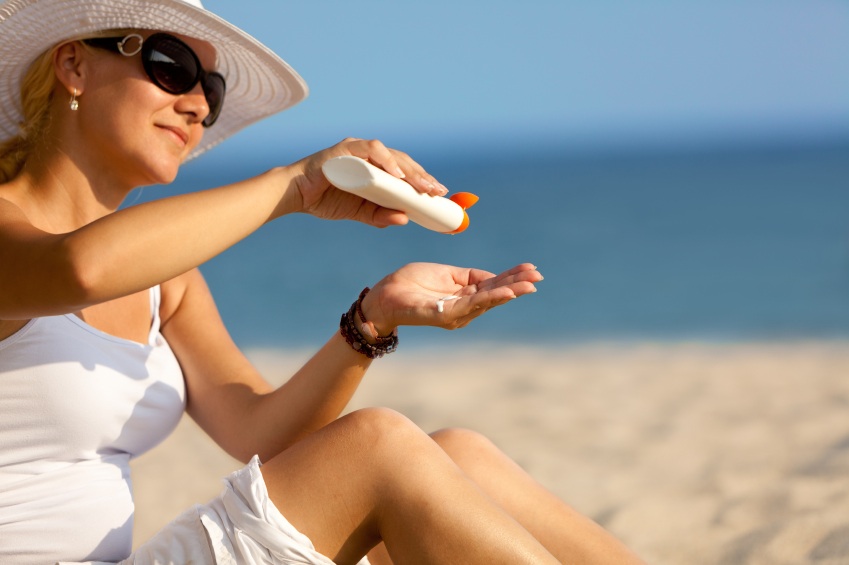Choosing a Sunscreen
 It is that time of year when we will be grabbing our swim suits and heading to the beach. Most of us have a tube of sunscreen stuffed away in a closet from last summer and you might be wondering if it is still good. Also, you may have heard many different claims about which sunscreen ingredients are the safest and which are ones to avoid. You want a product that really works, but is also safe. But choosing the right sunscreen can be confusing.
It is that time of year when we will be grabbing our swim suits and heading to the beach. Most of us have a tube of sunscreen stuffed away in a closet from last summer and you might be wondering if it is still good. Also, you may have heard many different claims about which sunscreen ingredients are the safest and which are ones to avoid. You want a product that really works, but is also safe. But choosing the right sunscreen can be confusing.
Don't Throw Last Year's Sunscreen Away (Unless…)
That tube of sunscreen you still have left from last summer should still be good, provided it was stored at room temperature, and the date hasn’t expired. If you left it in the glove compartment of your SUV or under a bed in the camper you might want to toss it. Long exposure to extreme temperatures can break down the active ingredients in most sunscreens and isn’t worth the risk.
Ingredients to Avoid
When choosing a sunscreen, finding one with safe and effective ingredients should be your first priority. This can be very difficult because the majority of brands carry one or more ingredients which are hazardous. Oxybenzone, for example is one you might want to avoid. One study found that the chemical was still present in the urine of test subjects up to six weeks after application! Parabens, phthalates, and artificial fragrances also are best avoided.
Ingredients to Look For
Next, look for a sunscreen which has zinc oxide, or titanium dioxide, as the main active ingredient. Better yet, look for one that contains both. These two ingredients have a long, proven safety factor. Both do a wonderful job at reflecting harmful UVA/UVB rays without the potential side effects of some the ingredients in other sunscreens. Just make sure that these ingredients are the non-nano particle type. This means that the molecules haven’t been reduced to a size that can be absorbed into the blood stream. A good sunscreen should lay on top of the skin instead of being absorbed like a moisturizer. (Note: Oryana does not sell products that contain nano particles)
Also, look for a sunscreen that claims to be Broad Spectrum. This means that it protects both UVA/UVB rays. UVA rays are the ones that can cause premature aging and some forms of skin cancer. UVB rays are the ones which cause most sunburns. You need to be protected from both UVA/UVB rays if we are going to be outside for very long.
Sun Protection Factor
When it comes to the numbers look for a product with at least 30 SPF. This will block about 94% of UVA/UVB rays. An SPF of 45 will block about 96%. Because no sunscreen can offer 100% protection, using products with higher SPF will not provide much additional benefit and are usually not worth the extra cost.
Water Resistance is Important (But there's no such thing as water-proof)
Because many people use sunscreen while enjoying their favorite water sport you should look for one that claims to be water resistant for at least 40 minutes. This is especially important for use with young children who are in and out of the water constantly. You don’t want to have to stop every 10 minutes to reapply.
Make Sure You Use Enough
Many people don’t apply enough sunscreen to get the proper effect. The recommended dose is to use a shot glass size dollop and spread evenly over all exposed skin areas. It is better to have too much than not enough. Try to apply at least 15 minutes BEFORE you are going to be exposed, if possible. If you are outside for an extended period, like for a picnic or a trip to the beach, you should reapply every 1 ½ to 2 hours.
Don't Forget Your Feet, Knees, and Lips
Don’t forget the tops of your feet if you are going barefoot, wearing flip-flops, or your favorite sandals. Bald heads need a generous amount too, if you are going hatless. Knees are often a missed spot, and can be a problem if you are out in a kayak, watching you kid’s ballgame, or just sitting in the sun for long period of time. Lips need protection too so look for a lip balm with an SPF of at least 15.
But You Still Need to Limit Sun Exposure
Another thing to consider is covering up more. Unless you are a life guard you might want limit the time you spend over-exposed to the sun. Wearing loose fitting tops with longer sleeves and longer summer skirts can be a big help protecting your skin. Broad brimmed hats and beach umbrellas are a good alternative.
Remember, over exposure to sun, even for short periods of time can do significant damage. If you want to avoid premature aging, or different types of skin cancer, then using a safe, effective sunscreen may be the best thing you can do for your body this summer.